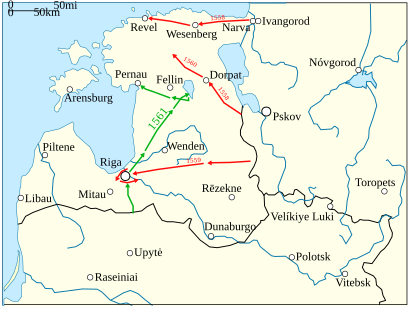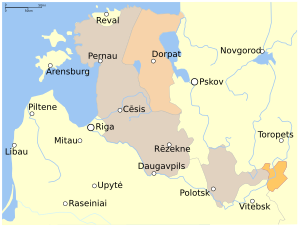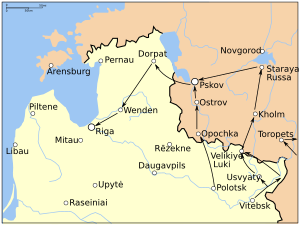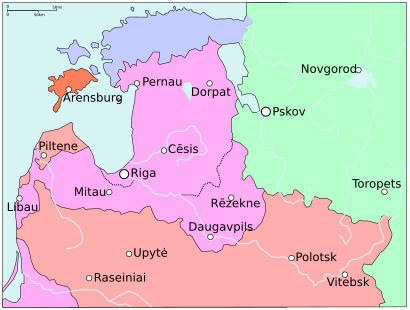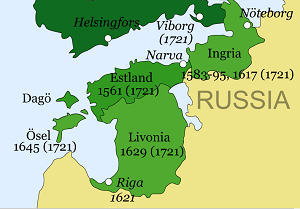Livonian War facts for kids
Quick facts for kids Livonian War |
|||||||||
|---|---|---|---|---|---|---|---|---|---|
 Siege of Narva by the Russians in 1558, by Boris Chorikov, 1836 |
|||||||||
|
|||||||||
| Belligerents | |||||||||
|
|
Qasim Khanate |
||||||||
| Commanders and leaders | |||||||||
Shahghali Sain-Bulat |
|||||||||
The Livonian War (1558–1583) was a big conflict fought for control of a region called Old Livonia. This area is now part of Estonia and Latvia. The war involved the Tsardom of Russia fighting against several other powerful countries. These included Denmark–Norway, the Kingdom of Sweden, and the Polish–Lithuanian Commonwealth.
From 1558 to 1578, Russia had many early wins. They captured important cities like Dorpat and Narva. Russia's actions led to the end of the Livonian Confederation. This brought Poland–Lithuania, Sweden, and Denmark into the war. Swedish Estonia was created, even with constant Russian attacks. Frederick II of Denmark bought some land and gave it to his brother, Magnus of Holstein. Magnus tried to create his own kingdom, the Kingdom of Livonia, which was a vassal state of Russia for a while.
In 1576, Stephen Báthory became King of Poland and Grand Duke of Lithuania. He changed the course of the war. His forces had big wins between 1578 and 1581. This included a joint attack with Sweden and Poland–Lithuania at the Battle of Wenden. After this, there was a long campaign into Russia, ending with the difficult Siege of Pskov. The war between Russia and Poland–Lithuania ended in 1582 with the Truce of Jam Zapolski. Russia lost all its land in Livonia and Polotsk to Poland–Lithuania. The next year, Sweden and Russia signed the Truce of Plussa. Sweden gained most of Ingria and northern Livonia, and kept Swedish Estonia.
Contents
Why the War Started
Livonia Before the War
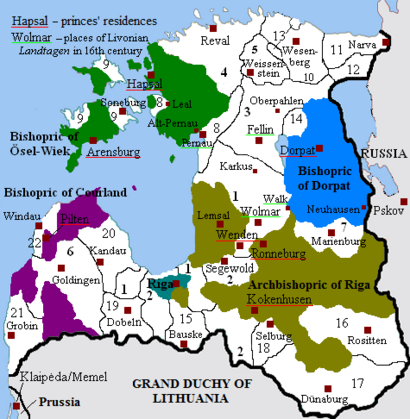
By the mid-1500s, Old Livonia was a rich region. However, it was divided and had a weak government. It was made up of different parts, like the Livonian Order and several bishoprics. Cities like Riga, Dorpat (Tartu), and Reval (Tallinn) were almost independent.
The different parts of Livonia often argued among themselves. They also had religious differences after the Protestant Reformation. This made Livonia weak and unable to defend itself. It was surrounded by powerful countries that wanted to expand their lands.
What Livonia's Neighbors Wanted
The Hanseatic League, a group of trading cities, was losing its control over trade in the Baltic Sea. Livonian ports like Riga and Reval (Tallinn) were left without strong protection.
Denmark had the strongest navy in the Baltic Sea. It controlled the entrance to the Baltic Sea and collected tolls. Denmark also held important islands like Bornholm and Gotland.
Sweden had limited access to the Baltic Sea. But it was growing stronger with its exports of timber, iron, and copper. Sweden also had a growing navy. It wanted to expand into Livonia to control trade with Russia.
The Tsardom of Russia had become very powerful. It had taken over nearby lands like Novgorod and Pskov. Russia wanted access to a year-round ice-free port on the Baltic Sea. Tsar Ivan IV demanded money from Livonia. When they didn't pay, he threatened to use military force. He wanted a way to trade with Western Europe and get better weapons.
The Polish King and Lithuanian Grand Duke Sigismund II Augustus was worried about Russia's plans. If Russia took Livonia, it would hurt Poland's trade. Sigismund supported his cousin, the archbishop of Riga. He hoped Livonia would become a state under Poland–Lithuania.
In 1556, there was a conflict within Livonia. The Archbishop of Riga and his ally were captured. This led to other countries trying to help. Finally, in September 1557, Sigismund invaded southern Livonia. He forced the Livonian groups to make peace. They signed the Treaty of Pozvol, forming an alliance against Russia. This agreement led to the start of the Livonian War.
1558–1562: The Livonian Order Falls Apart
Russia Invades Livonia
Ivan IV saw the Treaty of Pozvol as a reason for war. Livonia had promised Russia in 1554 not to ally with Poland–Lithuania. So, on January 22, 1558, Ivan invaded Livonia. Many local people saw the Russians as helpers against German control.
Russian troops quickly took Dorpat (Tartu) in May and Narva in July. They also started to attack Reval (Tallinn). Livonian forces, with help from Germany, managed to take back some forts. But Dorpat, Narva, and many other places stayed under Russian control.
Ivan continued to gain land in 1559 and 1560. In January 1559, Russian forces invaded Livonia again. A short truce was signed later that year.
Livonia asked for help from Poland–Lithuania. In June 1559, Livonia officially asked for Polish–Lithuanian protection. However, the Polish parliament did not fully agree to this.
Russian forces kept winning by using muskets and strong artillery. They captured important forts like Fellin (Viljandi). But they could not take big cities like Riga or Reval (Tallinn). The Livonian knights suffered a huge defeat at the Battle of Ērģeme in August 1560.
Eric XIV, the new King of Sweden, refused to help Livonia. So, Livonia turned to Sigismund for help. The weak Livonian Order was officially ended by the second Treaty of Vilnius in 1561. Its lands became the Duchy of Livonia and Duchy of Courland and Semigallia. These lands were given to the Grand Duchy of Lithuania.
Denmark and Sweden Join In
In 1559, Frederick II of Denmark-Norway bought the Bishopric of Ösel–Wiek. He made his brother, Magnus of Holstein, the bishop. Magnus then tried to expand his own lands. This caused problems with Sweden.
In 1561, Swedish forces arrived in Livonia. The local nobles in Harrien–Wierland and Jerwen joined Sweden. This created the Duchy of Estonia. Reval (Tallinn) also accepted Swedish rule. Sweden wanted to challenge Denmark's power in the Baltic Sea. This led to the Northern Seven Years' War.
In 1562, Swedish forces took Pernau (Pärnu). Sweden tried to protect Riga, which led to conflict with Sigismund. Sigismund had good relations with Eric XIV's brother, John III of Sweden. In 1562, John married Sigismund's sister, Catherine. This stopped her from marrying Ivan IV.
Eric XIV was angry when John lent money to Sigismund. John received seven Livonian castles as security. Eric XIV had John arrested in 1563. Sigismund then allied with Denmark and Lübeck against Eric XIV.
1562–1570: A Changing War
The entry of Denmark, Sweden, and Poland-Lithuania into Livonia started a fight for control of the Baltic Sea. This period saw less intense fighting from 1562 to 1570. Denmark, Sweden, and Poland–Lithuania were busy with the Nordic Seven Years' War (1563–1570). But Livonia remained very important.
In 1562, Denmark and Russia agreed to respect each other's claims in Livonia. In 1564, Sweden and Russia signed a seven-year truce.
Russia's War with Lithuania
When the truce between Russia and Lithuania ended in 1562, Ivan IV invaded Lithuania. His army attacked Vitebsk and took Polotsk in 1563. Lithuania won battles at Ula in 1564 and Czasniki in 1567.
Ivan continued to gain ground in central Livonia. But Lithuania held him back from the coast. These defeats and other problems led Ivan IV to move his capital. He also started a harsh policy against some of his nobles.
In 1566, Lithuania tried to make peace with Russia. Lithuania was willing to share Livonia with Russia. But Russian diplomats saw this as a sign of weakness. They demanded all of Livonia, including Riga. This was a problem for Lithuania, as much of their trade depended on Riga. No agreement was reached, and fighting started again.
In 1569, Poland and Lithuania officially joined together to form the Polish–Lithuanian Commonwealth. The Duchy of Livonia then came under their shared control. In June 1570, a three-year truce was signed with Russia.
Sigismund II, the first King of the Commonwealth, died in 1572. This led to a new election for the Polish throne. Some Lithuanian nobles wanted a Russian candidate. But Ivan demanded too much, so his son was not chosen. Instead, Henry of Valois became King.
Russia's War with Sweden
In 1564, Sweden and Russia agreed that Russia would recognize Sweden's control over Reval (Tallinn). Sweden accepted Russia's claims over the rest of Livonia. A seven-year truce was signed in 1565.
Eric XIV of Sweden was removed from power in 1568. His half-brother John III of Sweden became king. Both Russia and Sweden had other problems and wanted to avoid a costly war in Livonia.
Ivan IV wanted John's wife, Catherine, to be sent to Russia. She was a Polish-Lithuanian princess. In 1569, John sent a group of diplomats to Russia. Ivan refused to meet them. The Russian governor treated the Swedish diplomats very badly.
In May 1570, Ivan returned to Moscow. He signed a truce with the Commonwealth, so he no longer feared war with Poland–Lithuania. Ivan still demanded Catherine. He also demanded that Sweden give up Reval (Tallinn). Sweden refused, and the war started again.
Impact of the Northern Seven Years' War
The Northern Seven Years' War between Denmark-Norway and Sweden ended in 1570. This war was mainly fought in western Scandinavia. The Treaty of Stettin made Denmark the strongest power in Northern Europe.
Sweden had to agree to give up its lands in Livonia. In return, the Holy Roman Emperor was supposed to pay Sweden. But he never paid, so he lost his influence in the Baltic. The terms of the treaty about Livonia were ignored. So, the Livonian War continued. Ivan saw this as a chance for his enemies to unite against him.
1570–1577: Russia's Strong Period and the Kingdom of Livonia
In the early 1570s, King John III of Sweden faced strong Russian attacks in Estonia. Reval (Tallinn) survived a Russian siege in 1570 and 1571. But Russian forces took several smaller towns. In 1573, the Russians captured Paide. They treated the Swedish leaders very cruelly after the capture. This made John want revenge.
John's counter-attack failed at the siege of Wesenberg in 1574. His army had problems, and German and Scottish soldiers fought each other. The war was very expensive for Sweden. John had to give away some castles to pay his German soldiers.
Meanwhile, Magnus of Holstein tried to attack Swedish-controlled Reval (Tallinn). But he did not get help from Ivan or his brother, Frederick II of Denmark. The siege failed in March 1571.
At the same time, Crimean Tatars attacked Russian lands and burned Moscow. A drought and diseases also hurt the Russian economy. Ivan IV changed his army. He started using many native troops, Cossacks, and Tatars.
Ivan's campaign reached its peak in 1576. In 1577, 30,000 Russian soldiers entered Livonia. They attacked Danish areas because Denmark had taken some castles. Danish influence in Livonia ended. Swedish forces were attacked in Reval (Tallinn). Russian forces raided central Livonia.
The conquered lands submitted to Ivan or his helper, Magnus. Magnus was declared king of the Kingdom of Livonia in 1570. But Magnus later turned against Ivan IV. Ivan then attacked towns that had submitted to Magnus. The campaign then focused on Wenden (Cēsis), an important city in Livonia.
1577–1583: Russia's Defeat
Sweden and Poland–Lithuania Fight Back
In 1576, Stefan Batory became King of Poland and Grand Duke of Lithuania. He wanted to push Ivan IV out of Livonia. Batory first had to deal with a conflict with the city of Danzig (Gdansk). He gave the city more rights in return for money. He also got military support from Prussia.
Batory had to hire many soldiers from different countries. Swedish King John III and Stefan Batory allied against Ivan IV in December 1577.
By November, Lithuanian forces had captured Dünaburg. A Polish–Swedish force took Wenden in early 1578. Russian forces tried to retake Wenden but failed. In September, Ivan sent a large army of 18,000 men. They attacked Wenden. But a relief force of about 6,000 German, Polish, and Swedish soldiers arrived. In the Battle of Wenden, Russia suffered a big defeat. This was Ivan IV's first major loss in Livonia.
Batory improved his army, especially his cavalry and artillery. He gathered 56,000 troops for his first attack on Russia at Polotsk. Ivan's main forces were in Pskov and Novgorod. So, Polotsk fell on August 30, 1579. Batory then captured the fortress of Velikie Luki on September 5, 1580. Other forts also fell quickly.
In 1581, Batory's forces attacked Pskov. This was a very strong fortress. However, Batory's financial support from the Polish parliament was decreasing. He failed to draw Russian forces out into an open battle before winter. Ivan, not knowing Batory's problems, signed a truce.
The Swedish attack on Narva in 1579 failed. So, Pontus de la Gardie became the new Swedish commander. Swedish forces took Kexholm and Padise in 1580. In 1581, a mercenary army hired by Sweden recaptured the important city of Narva. This campaign used Sweden's strong navy. After Narva fell, Ivangorod, Jama, and Koporye also fell. Sweden was happy with its gains in Livonia.
Truces of Jam Zapolski and Plussa
Negotiations led by Antonio Possevino resulted in the 1582 Truce of Jam Zapolski. This truce was between Russia and the Polish–Lithuanian Commonwealth. It was a big loss for the Tsar. Russia had to give up all the areas it still held in Livonia. The city of Dorpat (Tartu) went to the Polish–Lithuanian Commonwealth. Polotsk also stayed under Commonwealth control. The truce was for ten years and was renewed twice.
The war with Russia ended for Sweden when the Tsar signed the Truce of Plussa with Sweden on August 10, 1583. Russia gave up most of Ingria. Narva and Ivangorod also came under Swedish control. This truce was first for three years and later extended.
After the War
After the war, the Duchy of Courland and Semigallia had a stable period. This was based on the 1561 Treaty of Vilnius. North of the Düna river, Batory reduced the special rights that Livonia had. He saw these lands as war prizes. Polish became the main administrative language. The Roman Catholic Church gained power in Livonia.
In 1590, the truce between Russia and Sweden ended. Fighting started again. The Russo-Swedish War of 1590–95 ended with the Treaty of Teusina. Sweden had to give Ingria and Kexholm back to Russia.
The alliance between Sweden and Poland began to weaken. The Polish King Sigismund III Vasa was also the heir to the Swedish throne. But he faced opposition from his uncle, Charles of Södermanland. Sweden then had a civil war. Sigismund was removed from the Swedish throne.
In 1600, local nobles in Livonia asked Charles for protection. Charles then drove Polish forces out of Estonia. He invaded the Livonian duchy. This started a series of Polish–Swedish wars. At the same time, Russia was in a civil war called the "Time of Troubles". Swedish and Polish–Lithuanian forces got involved on opposite sides.
Charles IX's forces were pushed out of Livonia after big defeats. Later, during the Ingrian War, Charles' successor Gustavus Adolphus retook Ingria and Kexholm. These lands were officially given to Sweden in the 1617 Treaty of Stolbovo. Sweden also gained most of the Duchy of Livonia. In 1621, Sweden captured Riga. Polish–Lithuanian forces were expelled from most of Livonia. This created the Swedish Livonia. Sweden's gains in Livonia were accepted in the 1629 Treaty of Altmark.
The Danish province of Øsel was given to Sweden in 1645. This was part of the Thirty Years' War. The situation stayed the same until 1710. Then, Estonia and Livonia surrendered to Russia during the Great Northern War. This was made official in the Treaty of Nystad in 1721.
Images for kids
See also
 In Spanish: Guerra livonia para niños
In Spanish: Guerra livonia para niños
- Livonians
- Russo-Turkish wars


